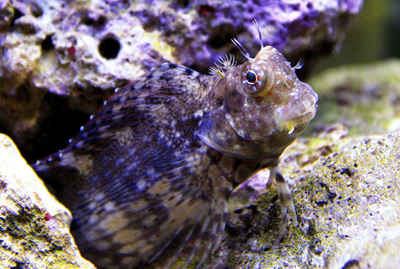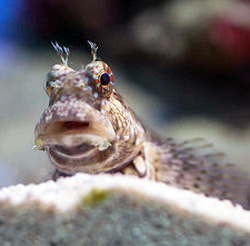The lawnmower blenny, aka the jeweled blenny, jeweled rockskipper, or sailfin blenny (Salarias fasciatus), is commonly purchased not just for its comical behavior and only-a-mother-could-love looks, but also for the utilitarian purpose of controlling algae in marine tanks. While you can pretty much count on this droll little fish to provide interest and entertainment, its performance when it comes to eradicating problem algae from aquaria can best be described as hit-or-miss.
Physical traits
S. fasciatus is “all blenny,” with an elongated body; long, continuous dorsal fin; blunt head; wide mouth; high-set, bulbous eyes; and frilly cirri on the head above and below the eyes. Color-wise, this fish is mottled in shades of brown, green, and white, and the eyes feature white stripes extending outward from the pupil in a radial pattern. Maximum length for this species is around 5 inches.
Feeding
The lawnmower blenny’s natural diet consists primarily of detritus and microalgae, which it continually rasps off the rockwork and substrate. One of the potential challenges of keeping this species is that aquarium specimens don’t always learn to accept prepared foods, so it’s important to keep them in well-established tanks with a good supply of their natural food items. Specimens kept in newly set up or overly “sterile” systems often starve. Those that do come around to prepared foods can be offered various green foods, such as frozen herbivore formulations and algae-based pellets.

With one of its many common names including the word “lawnmower,” you’d envision this fish mowing down irksome algae with joyful abandon. But if you’re introducing S. fasciatus strictly for the purpose of eradicating, say, hair algae, it’s important to manage your expectations because individual results will vary. There’s also something of a paradox to keeping this species for the utilitarian purpose of algae control: In order to sustain the blenny, an ongoing crop of algae must be present in the system—but then eliminating algae was the reason for adding the fish to begin with.
Housing
Being a bottom-dwelling species that hops around the rockwork and substrate, S. fasciatus does not demand much in the way of open swimming space. It does, however, need enough rockwork and substrate to support the microalgae and detritus it feeds upon, so don’t sell it short with respect to tank size. I wouldn’t go much smaller than 40 gallons, with bigger being better.
Compatibility
Lawnmower blennies are moderately peaceful but likely to fight with conspecifics, congeners, and similar species. And the smaller the tank, the more likely your blenny will squabble with tankmates it perceives as competitors for food or real estate.
These blennies can generally be considered reef safe, but like many herbivorous fish, their natural grazing activity may include nipping at sessile invertebrates.




